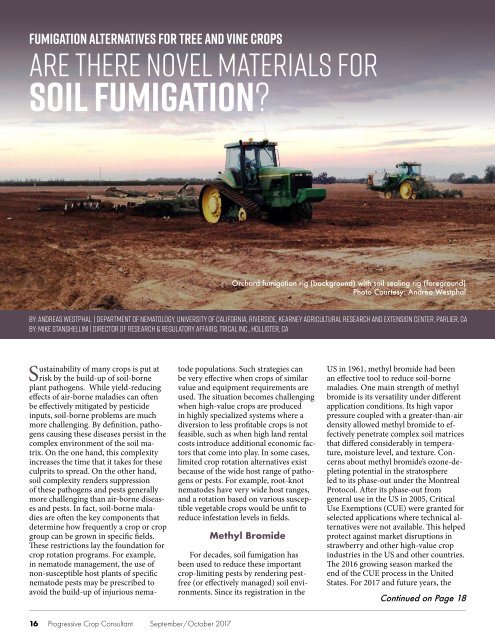September/October 2017
Create successful ePaper yourself
Turn your PDF publications into a flip-book with our unique Google optimized e-Paper software.
FUMIGATION ALTERNATIVES FOR TREE AND VINE CROPS<br />
Are there novel materials for<br />
soil fumigation?<br />
Orchard fumigation rig (background) with soil sealing rig (foreground)<br />
Photo Courtesy: Andrea Westphal<br />
By: Andreas Westphal | Department of Nematology, University of California, Riverside, Kearney Agricultural Research and Extension center, Parlier, CA<br />
By: Mike Stanghellini | Director of Research & Regulatory Affairs, TriCal Inc., Hollister, CA<br />
Sustainability of many crops is put at<br />
risk by the build-up of soil-borne<br />
plant pathogens. While yield-reducing<br />
effects of air-borne maladies can often<br />
be effectively mitigated by pesticide<br />
inputs, soil-borne problems are much<br />
more challenging. By definition, pathogens<br />
causing these diseases persist in the<br />
complex environment of the soil matrix.<br />
On the one hand, this complexity<br />
increases the time that it takes for these<br />
culprits to spread. On the other hand,<br />
soil complexity renders suppression<br />
of these pathogens and pests generally<br />
more challenging than air-borne diseases<br />
and pests. In fact, soil-borne maladies<br />
are often the key components that<br />
determine how frequently a crop or crop<br />
group can be grown in specific fields.<br />
These restrictions lay the foundation for<br />
crop rotation programs. For example,<br />
in nematode management, the use of<br />
non-susceptible host plants of specific<br />
nematode pests may be prescribed to<br />
avoid the build-up of injurious nema-<br />
tode populations. Such strategies can<br />
be very effective when crops of similar<br />
value and equipment requirements are<br />
used. The situation becomes challenging<br />
when high-value crops are produced<br />
in highly specialized systems where a<br />
diversion to less profitable crops is not<br />
feasible, such as when high land rental<br />
costs introduce additional economic factors<br />
that come into play. In some cases,<br />
limited crop rotation alternatives exist<br />
because of the wide host range of pathogens<br />
or pests. For example, root-knot<br />
nematodes have very wide host ranges,<br />
and a rotation based on various susceptible<br />
vegetable crops would be unfit to<br />
reduce infestation levels in fields.<br />
Methyl Bromide<br />
For decades, soil fumigation has<br />
been used to reduce these important<br />
crop-limiting pests by rendering pestfree<br />
(or effectively managed) soil environments.<br />
Since its registration in the<br />
US in 1961, methyl bromide had been<br />
an effective tool to reduce soil-borne<br />
maladies. One main strength of methyl<br />
bromide is its versatility under different<br />
application conditions. Its high vapor<br />
pressure coupled with a greater-than-air<br />
density allowed methyl bromide to effectively<br />
penetrate complex soil matrices<br />
that differed considerably in temperature,<br />
moisture level, and texture. Concerns<br />
about methyl bromide’s ozone-depleting<br />
potential in the stratosphere<br />
led to its phase-out under the Montreal<br />
Protocol. After its phase-out from<br />
general use in the US in 2005, Critical<br />
Use Exemptions (CUE) were granted for<br />
selected applications where technical alternatives<br />
were not available. This helped<br />
protect against market disruptions in<br />
strawberry and other high-value crop<br />
industries in the US and other countries.<br />
The 2016 growing season marked the<br />
end of the CUE process in the United<br />
States. For <strong>2017</strong> and future years, the<br />
Continued on Page 18<br />
16 Progressive Crop Consultant <strong>September</strong>/<strong>October</strong> <strong>2017</strong>


















